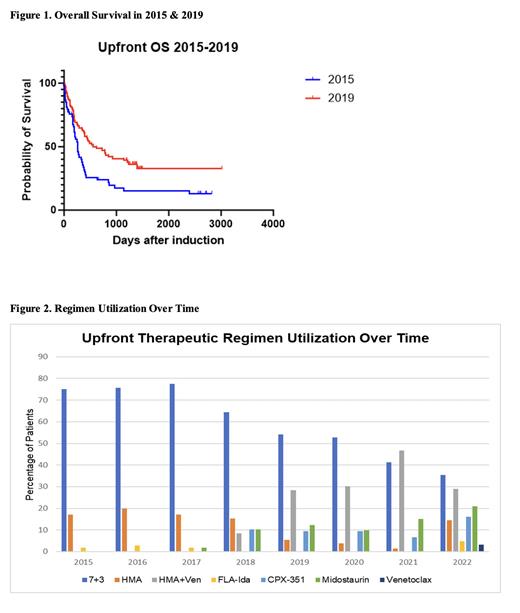Background:
Treatment approaches in acute myeloid leukemia are rapidly evolving due to a dynamic treatment landscape, routine molecular profiling, and the detection of measurable residual disease. Recently, there has been a surge in FDA approvals for novel therapies (e.g., midostaurin, gilteritinib, CPX-351, enasidenib, ivosidenib, and venetoclax), as well as a departure from a “one-size-fits-all” treatment approach. It is unclear, however, what effect these changes have had on overall survival over time. Since 2017, we have witnessed a significant introduction of novel therapeutics. We hypothesized that patients diagnosed after 2017 may have improved survival due to recent therapeutic advances.
Methods: We retrospectively analyzed 627 consecutive patients in the Project ERIS database aged > 18 years with AML treated at VCU Massey Comprehensive Cancer Center from 2015 to 2022. We limited the analysis to January 1, 2015 to December 31, 2019 to avoid confounding from the COVID-19 pandemic. We obtained cytogenetic and molecular characteristics, induction regimens, allogeneic stem cell transplant status, and survival data. The median overall survival (mOS) was compared across calendar years using the Kaplan-Meier method. Categorical variables were analyzed using Fisher's exact test.
Results: The median age at AML diagnosis was 62.9 years (range, 19.6-93.0), and the median ECOG performance status was 1 (range, 0-4). The median Charlson Comorbidity Index score was 5 (range, 0-14). There were 139 (22.2%) patients with ELN 2022 favorable-risk disease, 199 (31.7%) with intermediate risk, and 260 (41.5%) with adverse risk. The median OS of all patients diagnosed with AML in 2015 was 8.8 months. In 2016, the mOS was 14.5 months. There was a statistically significant improvement in mOS in 2016 compared to 2015 (HR 0.62 [95% CI 0.40-0.95], p = 0.027). The mOS in 2017, 2018, and 2019 was 12.9 months, 11.1 months, and 19.7 months, respectively. A significant improvement in OS was noted between 2015 and 2019 (HR 0.55 [95% CI 0.36-0.85], p = 0.003) in the entire cohort (Figure 1). When stratified by ELN 2022 genetic risk, clinically relevant improvement in OS was noted across all risk categories from 2015 to 2019, which reached statistical significance in the adverse risk group - favorable risk mOS: 16.4 months vs not reached (p = 0.141); intermediate risk: 13 months vs 18.7 months (p = 0.064); adverse risk: 7.2 months vs 13 months (p = 0.02). We observed expected changes in front-line treatment in this timeframe with decreased single-agent hypomethylating agent (HMA) usage in favor of HMA + venetoclax and increased intensive induction therapies outside of 7+3 (Figure 2). Strikingly, increased procession to allogeneic stem cell transplantation (HCT) was noted in the same timeframe (18.9% in 2015 vs 35.1% in 2019, p = 0.049).
Conclusions :
Our data demonstrate an emerging trend of clinically significant improvement in overall survival in patients with AML. The introduction of a multitude of therapeutic options may be associated with significantly improved survival over time. In addition to the advent of novel therapeutics leading to improved outcomes, the refinement of SCT conditioning regimens has likely led to the improved accessibility of HCT. In summary, we present an encouraging and significant trend of improved survival and access to HCT, particularly for patients with adverse-risk disease.
Disclosures
Maher:Sobi (Doptelet): Speakers Bureau; Bristol Myers Squibb: Membership on an entity's Board of Directors or advisory committees.


This feature is available to Subscribers Only
Sign In or Create an Account Close Modal